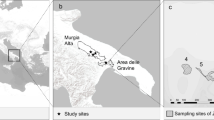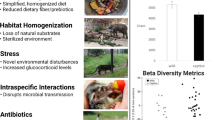Abstract
In this study, we demonstrate that the mountain hare and roe deer compete with each other. This was determined using "natural experiments" of populations found in sympatry and allopatry on the islands along the west coast of Norway. We demonstrate that both species occupy the same habitats, share the same food resources and that food availability is limited. Two browsing species as different in size as roe deer and mountain hare might be expected to partition the available vegetation (e.g. woody scrub) in terms of height above ground level. However, from the evidence collected, the feeding-height-separation hypothesis must be rejected as an explanation for ecological separation between roe deer and mountain hares because there was extensive height overlap in resource utilisation by both species and neither species changed its feeding height in response to the presence of the other. Total browse utilisation did not increase when both species were together; rather, species-specific browse utilisation declined when the other species was present. However, the foraging behaviour of each herbivore varied significantly between the allopatric and sympatric sites. When both herbivores were present, the clip diameter of shoots browsed by mountain hares declined to match those selected by roe deer, while roe deer switched from a browse-dominated diet to a diet dominated by winter-green gramineae. The change to smaller-diameter shoots likely resulted in the hare increasing its intake of digestion-inhibiting or toxic secondary metabolites, while the alternative choice of digging through the snow like roe deer to reach the winter-green gramineae is a practice considered energetically too costly for hares. On this basis, we conclude that the enforced switch to a nutritionally inferior diet by mountain hares at the sympatric sites may result in changes to growth rate and body size which consequently impact on mortality and may explain the competitive superiority of the roe deer.
Similar content being viewed by others
Author information
Authors and Affiliations
Additional information
Electronic Publication
Rights and permissions
About this article
Cite this article
Hulbert, I.A., Andersen, R. Food competition between a large ruminant and a small hindgut fermentor: the case of the roe deer and mountain hare. Oecologia 128, 499–508 (2001). https://doi.org/10.1007/s004420100683
Received:
Accepted:
Published:
Issue Date:
DOI: https://doi.org/10.1007/s004420100683




